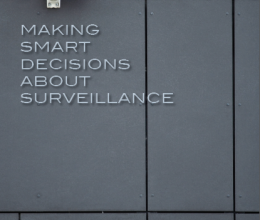
In this climate of heightened concerns about policing in America, many police departments and government officials are looking to body cameras. As of January 2015, at least 72 police departments in the United States had adopted body cameras or established pilot programs for their use. President Obama has announced federal funding to help purchase 50,000 body cameras for police.
The ACLU of California supports the use of body-worn video cameras by law enforcement, but only if they are used according to policies that assure accountability, protect privacy and promote transparency and community trust. When used properly, body cameras can deter police misconduct and uses of force, provide evidence to hold officers accountable when misconduct does occur and exonerate wrongly accused officers, and help the public understand how police operate.
But body cameras are only tools. Strong policies are crucial to ensure they further the goals of improved transparency and accountability, better policing and greater trust in law enforcement. The most crucial aspects of any body camera policy include:
Clear Rules When to Record, with Minimal Officer Discretion. Body cameras don’t advance accountability if police can turn them off when they don’t want to be recorded. Officers should record all interactions with the public, and definitely all investigatory interactions (including consensual encounters). Very limited exceptions for sensitive situations (such as in instances of sexual assault or recording inside homes) should be permitted, with clear, on-camera permission to stop recording—and departments must enforce recording policies by auditing officers’ compliance and imposing meaningful consequences for failure to activate cameras or tampering with equipment.
Clear Policy on Releasing Videos that Balances Privacy Concerns with the Public Interest in Transparency. Body cameras don’t provide transparency if the video is never released to the public. Setting the right balance between privacy and transparency in public access is tricky, but some situations are clear: when the video captures a critical incident (such as a serious use of force), when there are allegations of misconduct regarding the interaction captured on video, or when the subject of the video requests it, body camera video should be released.
Restrictions on Officer Review of Video. Officers involved in a critical incident like a shooting or facing charges of misconduct should not be permitted to view footage of the incident before making a statement or writing an initial report. Police do not show video evidence to other subjects or witnesses before taking their statements, and for good reason—cognitive science has demonstrated that watching video of an incident actually changes a person’s memory. Officers should watch the video after their initial statement and have the chance to offer more information and context. Because they may not remember a stressful incident perfectly, omissions or inconsistencies in their initial account shouldn’t be grounds for discipline without evidence they intended to mislead. This would provide the fullest picture of what happened without tainting officers’ initial recollection or creating the perception that body cameras are being used to cover up misconduct rather than to hold officers accountable.
Limitations on Use of Video. Body cameras shouldn’t be used for surveillance of the public, especially gathering of intelligence information based on First Amendment protected speech, associations, or religion. Departments should bar review of video unless there’s specific reason to believe that it contains evidence of a crime or misconduct, or as part of a randomized audit or a corrective action plan for an officer, and should prohibit analysis of video with other surveillance tools, such as facial recognition technology. An Open Process that Allows for Robust Public Participation. As set forth in the ACLU of California’s November 2014 report, Making Smart Decisions About Surveillance, detailed policies governing the uses of and restrictions on any new surveillance technology should be developed in advance through an open process with public input. Body cameras are no exception. Departments should submit proposed policies for body cameras and use of, access to, and release of video to their governing bodies, and allow those bodies to decide on final policies—and whether to adopt body cameras at all—through an open, transparent process.
Campaigns
- Los Angeles Police Department
- Pasadena Police Department:
 Letter - June 2, 2015
Letter - June 2, 2015 - Santa Ana Police Department:
 Letter - September 24, 2015
Letter - September 24, 2015